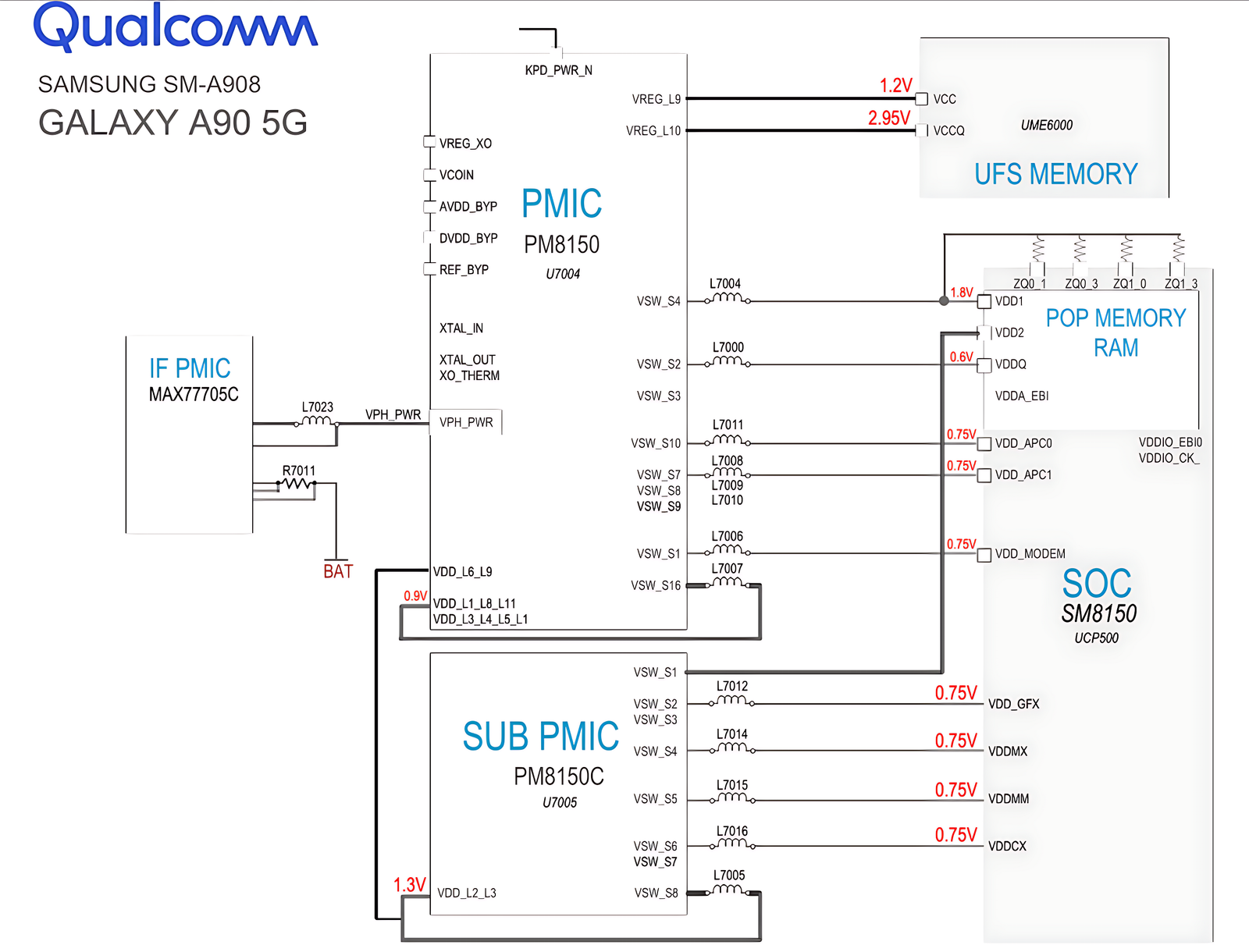Understanding the Samsung SM-A908 5G PM8150: Power Management for Efficient Performance
The Samsung Galaxy A90 5G (SM-A908) is a high-performance smartphone that features cutting-edge technology designed to provide users with a seamless and efficient experience. One of the most important components in ensuring the smartphone operates smoothly is the Power Management Integrated Circuit (PMIC), which is responsible for regulating and distributing power to various parts of the device. The PM8150 is the primary power management chip in the A90 5G, handling the distribution of voltage across the phone’s key components, ensuring everything works efficiently.

The Role of the PMIC (Power Management Integrated Circuit)
A PMIC is a crucial part of modern smartphones, especially when devices are packed with high-end processors, memory, and other power-hungry components. The PMIC ensures that power is distributed to each part of the device, from the system-on-chip (SOC) to the memory, display, and other peripheral components. It not only supplies the necessary voltage but also protects sensitive components from excessive power that could damage them.
In the Samsung Galaxy A90 5G, the PM8150 chip takes charge of regulating power for essential components such as the SOC (SM8150), memory, and display. Let’s take a closer look at how the PM8150 chip is laid out in the circuit and how it works to ensure efficient power management.
Overview of the PM8150 Circuit Diagram
The circuit diagram for the Samsung Galaxy A90 5G PM8150, shown above, reveals the structure and power distribution system of the smartphone. The PM8150 chip is at the heart of the power management system, connecting to various power supplies and voltage regulators to maintain the required voltage levels for the phone’s components.
Key Components and Connections in the Diagram:
- PM8150 PMIC Chip: The PM8150 chip, located on the right side of the diagram, is responsible for supplying power to the key components of the Galaxy A90 5G, including the SOC, RAM, and other important parts.
- Voltage Regulators (VREG): The PM8150 controls several voltage regulators like VREG_L9, VREG_L10, and VREG_L2. These regulators convert the battery voltage to the required levels for different components. For example:
- VREG_L9 provides 1.2V to power the UFS Memory.
- VREG_L10 delivers 2.95V for powering the UFS Memory.
- VREG_L2 outputs 0.9V for lower-power components.
- Power Switches (VSW): Power switches like VSW_S4 and VSW_S3 regulate power flow to different sections of the phone. They help manage energy distribution based on the current requirements of the device. For example, VSW_S4 provides 0.75V for powering the SOC.
- Sub PMIC (PM8150C): The sub PMIC, identified as PM8150C, helps distribute power to specific low-power components, like the POP Memory RAM and various modem circuits.
Power Distribution to Different Components
1. System-on-Chip (SOC)
The SOC (SM8150) is the heart of the Galaxy A90 5G, performing the heavy lifting of processing tasks like running applications, handling multimedia, and managing network communications. The PM8150 provides stable power to the SOC through multiple regulators. Voltage levels of 0.75V and 0.75V for different SOC components are needed to ensure that the processor performs efficiently during tasks like gaming, video playback, and multitasking.
2. POP Memory RAM
The POP Memory RAM is a type of embedded memory used to store active data, including the operating system and active applications. The PM8150 regulates the voltage for this memory to ensure that read and write operations are fast and reliable. The voltage provided to this section is typically 1.8V and 0.6V to keep memory operations stable.
3. UFS Memory
UFS (Universal Flash Storage) is used for the long-term storage of data in the Galaxy A90 5G. UFS memory is faster and more efficient than traditional storage methods, and it requires precise voltage regulation. The PM8150 ensures that the UFS memory receives the required voltage of 1.2V and 2.95V, which is crucial for ensuring fast read and write speeds.
Efficiency and Battery Life
The efficiency of power distribution is critical for ensuring that the device has a long-lasting battery life. The PM8150 helps the Galaxy A90 5G achieve this by efficiently managing power to each component, ensuring that each part of the phone operates at its optimal voltage without wasting excess energy. By distributing power based on real-time requirements, the PM8150 reduces unnecessary power consumption and heat generation, leading to a more efficient device.
Why Efficient Power Distribution Matters:
- Battery Life: Efficient power management helps the phone last longer on a single charge, allowing users to use their devices for extended periods without worrying about running out of battery.
- Thermal Efficiency: By distributing power intelligently, the PM8150 reduces unnecessary power usage, minimizing heat generation and ensuring the phone stays cool even during heavy use.
- Component Protection: Excessive voltage can damage delicate components over time. The PM8150 ensures that each component receives only the voltage it needs, increasing the longevity of the device.
Conclusion
The PM8150 Power Management IC plays a critical role in the performance and efficiency of the Samsung Galaxy A90 5G. By regulating power across essential components like the SOC, RAM, UFS memory, and more, the PM8150 ensures that the device operates optimally while maintaining a long battery life and preventing overheating. As smartphone technology continues to advance, the role of PMICs like the PM8150 will remain essential for providing users with high-performance devices that are energy-efficient, fast, and reliable.
